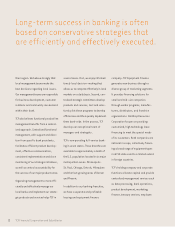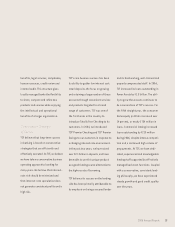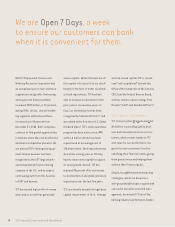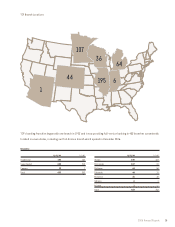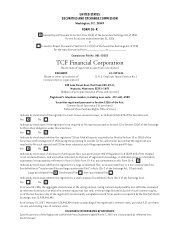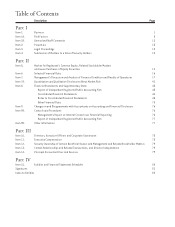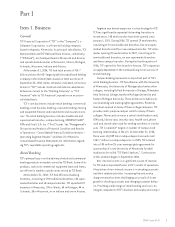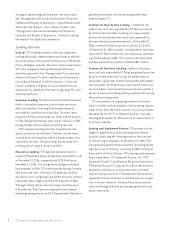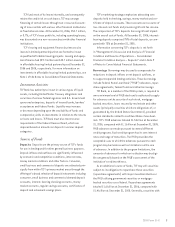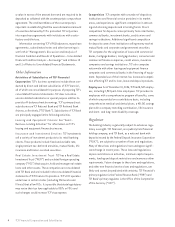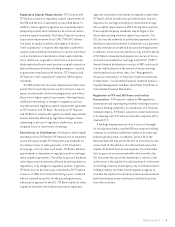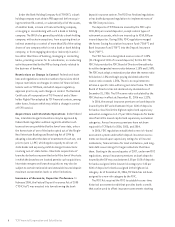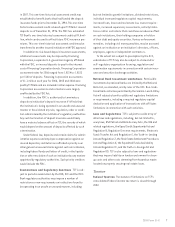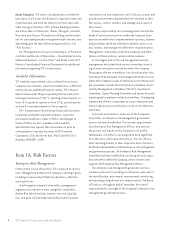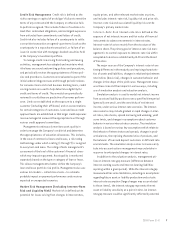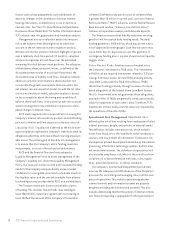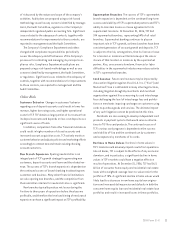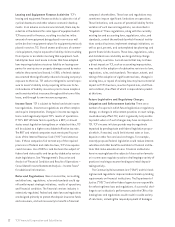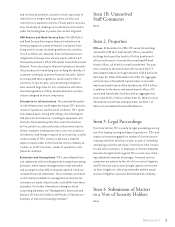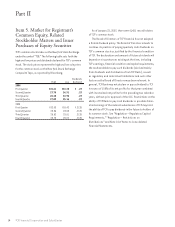TCF Bank 2006 Annual Report Download - page 24
Download and view the complete annual report
Please find page 24 of the 2006 TCF Bank annual report below. You can navigate through the pages in the report by either clicking on the pages listed below, or by using the keyword search tool below to find specific information within the annual report.
a value in excess of the amount borrowed are required to be
deposited as collateral with the counterparty to a repurchase
agreement. The creditworthiness of the counterparty is
important in establishing that the overcollateralized amount
of securities delivered by TCF is protected. TCF only enters
into repurchase agreements with institutions with a satis-
factory credit history.
Information concerning TCF’s FHLB advances, repurchase
agreements, subordinated notes and other borrowings is
set forth in “Management’s Discussion and Analysis of
Financial Condition and Results of Operations – Consolidated
Financial Condition Analysis – Borrowings” and in Notes 10
and 11 of Notes to Consolidated Financial Statements.
Other Information
Activities of Subsidiaries of TCF Financial
Corporation TCF’s business operations include those con-
ducted by direct and indirect subsidiaries of TCF Financial,
all of which are consolidated for purposes of preparing TCF’s
consolidated financial statements. TCF does not utilize
unconsolidated subsidiaries or special purpose entities to
provide off-balance sheet borrowings. TCF’s primary direct
subsidiaries are TCF National Bank and TCF National Bank
Arizona, collectively,(“TCF Bank”). Subsidiaries of TCF Bank
are principally engaged in the following activities.
Leasing and Equipment Finance See “Item 1.
Business-Lending Activities” for information on TCF’s
leasing and equipment finance businesses.
Insurance and Investment Services TCF Investments
sell a variety of investment products to its retail banking
clients. These products include fixed and variable rate,
single premium tax-deferred annuities, mutual funds, life
insurance and broker-assisted securities.
Real Estate Investment Trust TCF has a Real Estate
Investment Trust (“REIT”) and a related foreign operating
company (“FOC”) that acquire, hold and manage real estate
loans and other assets. These companies are consolidated
with TCF Bank and are included in the consolidated financial
statements of TCF Financial Corporation. TCF’s FOC operates
under laws in certain states (including Minnesota and
Illinois) that allow FOCs. It is possible that state legislatures
may revise their tax laws applicable to REITs or FOCs and
such changes could increase TCF’s tax expense.
Competition TCF competes with a number of depository
institutions and financial service providers in its market
areas, and experiences significant competition in attract-
ing and retaining deposits and in lending funds. Direct
competition for deposits comes primarily from retail banks,
commercial banks, investment banks, credit unions and
savings institutions. Additional significant competition
for deposits comes from institutions selling money market
mutual funds and corporate and government securities.
TCF competes for the origination of loans with commercial
banks, mortgage bankers, mortgage brokers, consumer and
commercial finance companies, credit unions, insurance
companies and savings institutions. TCF also competes
nationwide with other leasing and equipment finance
companies and commercial banks in the financing of equip-
ment. Expanded use of the Internet has increased competi-
tion affecting TCF and its loan, lease and deposit products.
Employees As of December 31, 2006, TCF had 8,547 employ-
ees, including 2,902 part-time employees. TCF provides its
employees with a comprehensive program of benefits, some
of which are provided on a contributory basis, including
comprehensive medical and dental plans, a 401(k) savings
plan with a company matching contribution, life insurance
and short- and long-term disability coverage.
Regulation
The banking industry is generally subject to extensive regu-
latory oversight. TCF Financial, as a publicly held financial
holding company, and TCF Bank, as a national bank with
deposits insured by the Federal Deposit Insurance Corporation
(“FDIC”), are subject to a number of laws and regulations.
Many of these laws and regulations have undergone signifi-
cant change in recent years. These laws and regulations
impose restrictions on activities, minimum capital require-
ments, lending and deposit restrictions and numerous other
requirements. Future changes to these laws and regulations,
and other new financial services laws and regulations, are
likely and cannot be predicted with certainty. TCF Financial’s
primary regulator is the Federal Reserve Bank (“FRB”) and
TCF Bank’s primary regulator is the Office of the Comptroller
of the Currency (“OCC”).
4TCF Financial Corporation and Subsidiaries


